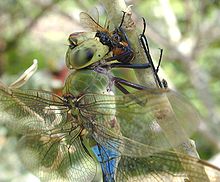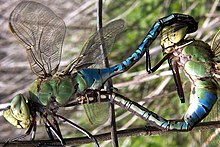American royal dragonfly
| American royal dragonfly | ||||||||||||
|---|---|---|---|---|---|---|---|---|---|---|---|---|

American royal dragonfly ( Anax junius ), ♂ |
||||||||||||
| Systematics | ||||||||||||
|
||||||||||||
| Scientific name | ||||||||||||
| Anax junius | ||||||||||||
| ( Drury , 1773) |
The Green Darner ( Anax junius ) is a dragonfly from the family of aeshnidae (Aeshnidae). This species is one of the largest North American dragonflies.
features
The males of the American royal dragonfly are about 3 inches long and reach a wingspan of 10.4 cm, the females are up to 8 cm long and reach a wingspan of up to 10.6 cm.
The breast and the head (including the compound eyes ) of the male are solid green with a few black markings. The abdomen of the male is light blue on top and a little green only behind. It has a black ribbon drawing.
The female also has a green breast with small black markings. However, it has brown compound eyes. The abdomen is predominantly green and reddish-brown and has a broad black stripe above. With their well-developed compound eyes, the animals see quite well. The wings are a touch of yellow and have a reticulate pattern.
Occurrence
The distribution area of the American dragonfly extends from the far north of the North American continent ( Alaska ) to Central America ( Panama ) and the islands of the Caribbean . Their occurrence ranges from the east coast to the west coast and in many cases beyond. It can be found on the East Asian peninsula of Kamchatka as well as in eastern China , Japan and Hawaii .
Their preferred habitats are near larger ponds , lakes , bays , estuaries and slowly flowing streams .
The American royal dragonfly undertakes long migrations across parts of the North American continent and the adjacent sea. For example, swarms of dragonflies are often observed at sea by workers on the oil rigs in the Gulf of Mexico or in southern California . It is believed that the withdrawing southward dragonflies in the warmer waters, for example in Mexico produce a winter generation flying north again as soon as the aquatic nymphs Imagines have become. Even before the wintering nymphs in the north turn into airborne dragonflies in spring, the swarms from the south appear there, laying their eggs underwater in the plants, where their offspring can develop over the summer. However, the development time depends on the temperature in the waters and can extend over several years in the north.
Lifestyle and diet

Like all dragonflies, the American royal dragonfly is a predator and prey on wasps , butterflies , mosquitoes and other flying insects as well as other dragonflies. Like all noble dragonflies , the American royal dragonfly can move very far from the water during hunting flights. The males, like the closely related Great Royal Dragonfly ( Anax imperator ), form territories and drive away other male dragonflies that could compete with them there.
Reproduction
Mating is often done in flight. Unlike many other dragonflies of the genus Anax , the pair does not separate, and the female lays the eggs together with the attached male in tandem . This behavior offers the female protection from other males when laying eggs and gives the male the security that the eggs he has fertilized will be laid. The female pricks the submerged parts of the aquatic plants and lays the eggs directly in the plant.
Larval development
The nymphs of the dragonflies are up to 55 millimeters long. They eat tadpoles , eggs and aquatic larvae of insects, crustaceans and small fish . Among the insect larvae, the larvae of the tufted mosquito and the mosquito are preferred food, but larvae of dragonflies are not spurned either. Among the crustaceans, not only amphibians , but also young crayfish (e.g. Procambarus clarkii ) up to a length of 3 centimeters , if they live in the same biotope .
gallery
Individual evidence
- ↑ Jeffrey Hahn: Insects of the North Woods. Kollath & Stensaas Publishing, 2009, p. 16 ISBN 978-0-9792006-4-9
- ↑ Eric R. Eaton, Kenn Kaufman: Kaufman Field Guide to Insects of North America. Houghton Mifflin Company, 2006, p. 42 ISBN 978-0-618-15310-7
- ^ S. Cannings, R. Cannings: Distribution of the Dragonflies (Insecta: Odonata) of the Yukon Territory, Canada, with notes on ecology and behavior. Contributions to Natural Science, 13, Royal British Columbia Museum, 1991
- ^ Arthur V. Evans: Field Guide to Insects and Spiders of North America. Sterling Publishing Co., 2007, p. 62 ISBN 978-1-4027-4153-1
- ^ DR Paulson, 2007: Anax junius. In: IUCN 2010. IUCN Red List of Threatened Species. Version 2010.4. Retrieved December 21, 2010
- ↑ Ethan Bright and Mark F. O'Brien: Keys for, and notes on, the dragon and damselfly larvae found in the State of Michigan. University of Michigan , 1999 (identification key ( Memento of the original from April 11, 2011 in the Internet Archive ) Info: The archive link was automatically inserted and not yet checked. Please check the original and archive link according to the instructions and then remove this note. To distinguish the larvae from Anax longipes and Anax junius )
- ↑ Todd C. Folsom and Nicholas C. Collins: The Diet and Foraging Behavior of the Larval Dragonfly Anax Junius (Aeshnidae), with an Assessment of the Role of Refuges and Prey Activity. Oikos, 42, 1, pp. 105-113, 1984
- ↑ John F. Witzig, Jay V. Huner, James W. Avault Jr .: Predation by Dragonfly Naiads Anax junius on Young Crawfish Procambarus clarkii . Journal of the World Aquaculture Society, 17, 1-4, pp. 58-63, December 1986 doi : 10.1111 / j.1749-7345.1986.tb00555.x
literature
- Dru Drury : Illustrations of Natural History. Vol. 2. White, London, 1773 (first description)
- Cynthia Berger and Amelia Hansen: Wild Guide: Dragonflies. Stackpole Books, Mechanicsburg 2004 ISBN 0-8117-2971-0
- Sidney W. Dunkle: Dragonflies through Binoculars: A Field Guide to Dragonflies of North America. Oxford University Press, New York 2000 p. 33 ISBN 0-1951-1268-7
Web links
- Anax junius at Animal Diversity Web ( University of Michigan Museum of Zoology)
- Common Green Darner ( Anax junius ) at Texas Parks and Wildlife (English)
- Green Darner Dragonfly - Anax junius Description (English) and photos on Cirrusimage









